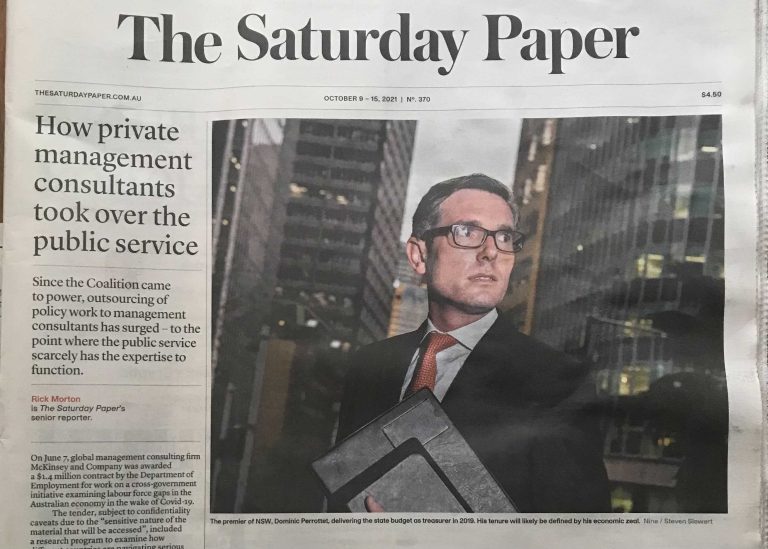Have specialist women’s units passed their use by date? This seems to be the message of the recent announcement that the once iconic Office of the Status of Women was to be moved from the Department of Prime Minister and Cabinet to the Department of Family and Community Services. Minister Kay Patterson retains the title as Minister assisting the Prime Minister in this area.
The shift from a coordinating high status Department like PM&C to an ever less significant policy and funding Department must be seen as a downgrade. More importantly, its shift to F&CS seems to represent a wider view of the Government that women are safely tucked back into their family roles, unless they can compete in the public sphere in male terms.
The proof of this last pudding recipe was an announcement on the same day of the appointment of four new females as departmental secretaries. This makes six women out of nineteen Departmental heads, thereby proving, in the PM’s terms, that, as they had made it on their merits, it was alright to downgrade the Office to an outer area.
But have women really made it, or do we need to reframe the issues? Can the seventies rhetoric about disadvantage be turned to some discussion of the ethics of unfairness?
It is thirty years since the first women’s adviser was appointed by the Whitlam government. Liz Reid joined Whitlam’s staff in 1974 and shortly afterwards, a secretariat was established in the Prime Minister’s public service department and the femocrat was born. This term and role were Australian inventions and represented an interesting initiative in advising governments through specialist units, based on the proposition that there were few women in senior ranks of politics and the public service and therefore decisions were made without considering the differential ways that much policy affected women. Special advisers were therefore assumed to be essential to ensure that good balanced advice could be offered on policies and practices.
There were many other units being set up at both State and Federal levels. The consensus then was that these units were useful and should perform a central role of over-viewing all government actions and commenting on Cabinet papers. The Fraser government was heavily criticized for taking the Office out of the Prime Minister’s Department into the Department of Home Affairs but it was rapidly moved back to PM&C under Hawke. Units were established in other portfolios, initially to inform government what women wanted and later as portals and contact point, useful to tell women what the government was doing for them.
By the mid-nineties, women’s policies became less visible at the Federal level. Women’s groups have been partly contained by the funding of a limited number of secretariats and pressured to represent their members’ views and not presume to offer their expertise. The need for diverse inputs into decision making has been downgraded into statistical exercises that have failed to recognise the dangers of limited advice in monocultural organisations. Equitable decision making has been overtaken by individual equal opportunity and if the numbers are balanced that’s all that matters.
There have been many changes in the last three decades but it’s measured in numbers: more women in jobs, more in education, especially at the higher level where they now often exceed men. There are more women in Parliament but still a minority, especially at Ministerial level. There are two in the Federal Cabinet and four in the outer Ministry; there are seven in the shadow cabinet. The question instead should be how influential are the women who are there, can they offer different view points and what changes they have been able to make?
The last election’s focus was on the mainstream which is seen to be essentially family-focused and traditional. So other groups such as youth, indigenous, disability and immigrants were also off the agenda as so-called ‘special interest’ – not seen as worth wooing. The one area that affected women was child care funding but no women’s groups were consulted and the policy is seriously flawed. The fee rebates offered will follow the Medicare rebates in encouraging providers to raise fees to absorb the extra payments and women will not gain much, if anything.
So the recent announcement that the Office for the Status of Women will move into F&CS reflects the long term marginalization of the issues. The Office has not been able to use its position effectively in a co-ordinating department for some time. Few if any Cabinet minutes were seen by the Office. Its main role was to administer a small amount of grant money, organize an occasional conference and presumably provide some advice internally. The move only makes clear the changes that have already occurred.
In the eyes of their masters the administering of small grants is probably seen as the main role of the OSW. This role is mirrored in many state women’s units and may well be useful to the groups that receive the grants but running a funding program may diminish their legitimacy as policy advisers. The demotion and low status of these units is reinforced by these roles in which other central agencies do not involve themselves. On the other hand, if they have no real power, why reject the money?
However, be aware that there is the possibility of a new equity group A review document being circulated on the Higher Education Equity Program suggests that men in the fields of Nursing, Society and Culture and Education studies should be designated an equity group, with appropriate targets set for their participation: forty per cent in Society and Culture and Education, and initially twenty per cent in Nursing (p56-57). This follows the concern expressed earlier this year by the PM at the lack of men in primary teaching as role models for boys. What this government’s concern for lower participation rates ignores is that those men who are in these areas are all over represented in the senior ranks, for example, eighty per cent of Directors of Nursing although only twenty per cent of the profession with similar imbalances in the teaching statistics.
It’s those numbers games again. We used them in the early years because it was a shorthand for many of the other problems women faced but now I suggest it’s time to move on. If the government can claim men who avoid low paid jobs, such as nursing, are therefore disadvantaged, even when they occupy a disproportionate number of these senior jobs, then we need to rethink our arguments. We need to move from counting victims and expecting the victors to be nice to us, to discussing why the present system is both dysfunctional and unethical. How can it be ethical to make high office hard for women who have family responsibilities? Is it ethical to make decisions that lack the full information on who will be affected?
Women’s roles and skills are still undervalued. Jobs where women are the majority are still grossly underpaid which is why men won’t do them; gender roles in the home leave much to be desired. The problems continue but we need to recast the questions so gender is no longer the basis for numerical counts. Culture changes still need to happen. Perhaps the new interest in ethics may be an entry point.



